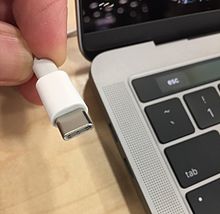USB-C
USB-C (formerly known as USB Type-C ) is a 24-pin USB connector system that is characterized by its double, rotationally symmetrical connector. The USB Type-C specification 1.0 was published by the USB Implementers Forum and completed in August 2014. In July 2016 it was adopted by the IEC as "IEC 62680-1-3". A device with a Type-C connector does not necessarily implement USB, a USB power supply, or any alternative technology. For example, USB-C is now sold in most Android smartphones and many laptop manufacturers have a USB-C interface, which is usually adapted in parallel with Thunderbolt-3 .
Overview
target
The original goal of USB-C was the standardization and miniaturization of the now growing proliferation of physical connections to computers, tablets and smartphones. This contains:
- USB-A on the host,
- USB-B 2.0 standard, USB-B 2.0 mini, USB-B 2.0 micro, USB-B 3.0 standard, USB-B 3.0 mini, USB-B 3.0 micro on the devices,
- DVI, DisplayPort , Mini-DisplayPort, HDMI , Mini-HDMI and Micro-HDMI on the host,
- classic power supply, powered USB, USB-A with various current delivery capabilities and
- the 3.5 mm jack plug for connecting speakers, headphones and microphones.
You can practically use one semi-passive cable at the same time
- load a notebook
- connect one or two displays
- Listen to music.
Pin assignment
| Pin code | Surname | description |
|---|---|---|
| A1 | GND | Dimensions |
| A2 | SSTXp1 | SuperSpeed differential pair # 1, TX, positive |
| A3 | SSTXn1 | SuperSpeed differential pair # 1, TX, negative |
| A4 | V BUS | tension |
| A5 | CC1 | Configuration channel |
| A6 | Dp1 | USB 2.0 differential pair, position 1, positive |
| A7 | Dn1 | USB 2.0 differential pair, position 1, negative |
| A8 | SBU1 | Sideband Usage 1 |
| A9 | V BUS | tension |
| A10 | SSRXn2 | SuperSpeed differential pair # 4, RX, negative |
| A11 | SSRXp2 | SuperSpeed differential pair # 4, RX, positive |
| A12 | GND | Dimensions |
| Pin code | Surname | description |
|---|---|---|
| B12 | GND | Dimensions |
| B11 | SSRXp1 | SuperSpeed differential pair # 2, RX, positive |
| B10 | SSRXn1 | SuperSpeed differential pair # 2, RX, negative |
| B9 | V BUS | tension |
| B8 | SBU2 | Sideband usage 2 |
| B7 | Dn2 | USB 2.0 differential pair, position 2, negative |
| B6 | Dp2 | USB 2.0 differential pair, position 2, positive |
| B5 | CC2 | Configuration channel |
| B4 | V BUS | tension |
| B3 | SSTXn2 | SuperSpeed differential pair # 3, TX, negative |
| B2 | SSTXp2 | SuperSpeed differential pair # 3, TX, positive |
| B1 | GND | Dimensions |
Examples
Since the MacBook from 2015, Apple has relied entirely on USB-C and, at the same time, Thunderbolt-3 in its entire MacBook series. But at the market launch, acceptance for this innovation was limited. Many buyers were frustrated that they couldn't even connect a traditional wired mouse or SD card , and third-party vendors responded. They offered so-called hubs, with which the functionality with the old connections could be granted.
Practically all newer Android smartphones have a USB-C port.
Individual evidence
- ↑ USB-C: Everything you need to know about the new wonder connector. Retrieved March 5, 2020 .
- ↑ IEC - News> News log 2016. Accessed March 5, 2020 .
- ↑ Thunderbolt 3 and USB-C: A Small Difference. Retrieved March 5, 2020 .
- ↑ contains electronics for signal processing, but no separate devices such as USB host adapters, graphics cards or other PCI Express devices.
- ↑ Identify the connections on the Mac. Retrieved March 15, 2020 .


